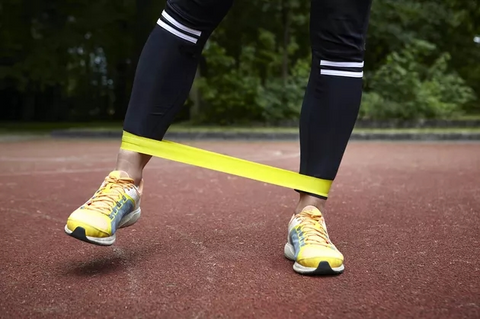Hip abduction is when the upper-leg bone, the femur, is moved out to the side and away from the body. Hip abduction exercises are important because they strengthen the muscles that stabilize the femur into the hip joint. To work the hip abductor muscles, perform the hip abduction exercises one to three times a week. These exercises will challenge and tone the hip abductor muscles.

Learn About Hip Abductors
A total of six muscles collaborate to perform hip abduction. The sartorius muscle commences at the top, front of your hip, and extends into your inner, lower leg bone. The tensor fascia lata is a small muscle that sits on the outer portion of your hip and inserts into your iliotibial band. The gluteus maximus is the largest and outermost butt muscle. It too inserts into the iliotibial band.
The piriformis starts at your sacrum and stretches out to your femur. The gluteus medius lies underneath the gluteus maximus and the gluteus minimus lies underneath the gluteus medius. A 2016 study in the Journal of Physical Therapy Science suggests that the gluteus medius plays a pivotal role in preventing injury to the lower extremities. If the muscle becomes weak, then the hip joint's angle of abduction increases, and the risk of an ACL injury occurs.
Read more: What Muscles Do Side Leg Raises Work?
Perform Squat Walks
Tie an elastic band around your ankles such as an exercise band or rubber tubing. Make sure there is resistance with your feet hip-width apart. Start with low resistance and progressively work your way up to heavier resistance. Stand with your hands on your hips and feet hip-width apart. Bend your knees 45 degrees. Keep your knees directly over your ankles. Step out with your right foot. Pause. Step in with your left foot, returning your feet to hip-width. Continue for 20 steps. Repeat on the other side, leading with your left foot.
Stand for Side-Leg Raises
Stand with your feet slightly wider than hip-width apart. Turn your right toes out 45 degrees and bend your right knee to 45 degrees. Bring all your body weight into your right leg and come on to the toes of your left foot. Raise your left leg as high as possible. Keep your left hip extended and your left leg straight. Slowly lower your left leg to the floor. Gentle tap your left big toe on the floor, then raise your leg back up. Complete 20 repetitions. Switch and do the other side.
You can also perform standing leg raises with exercise tubing. Loop the tubing around your left foot and stand on the length of the tube with your right foot. Lift your left leg out to the side and down again maintaining proper posture throughout. Keep your abs tight and hang on to a chair if balance is an issue says Mayo Clinic. Perform 12 to 15 reps on both sides.
Read more: The Benefits of Leg Raise Exercises
Sit for Side-Leg Raises
Come to the floor and lie on your right side. Bend your right elbow and place your head in your right palm. Make a straight line from your right elbow to your right heel. Place your left hand on the floor in front of your chest. Slowly lift your left leg into the air no more than 45 degrees, says the American Council on Exercise, as that is the degree to which the thigh can only abduct. Keep your left hip extended and your left leg straight. Pause at the top. Slowly lower your leg down but do not let it touch your right leg. Complete 20 repetitions. Repeat on the other side.


